This post may contain affiliate links. I only recommend products or services that I personally use or trust, promise!

Yangnyeom gejang is my all-time favorite Korean dish! I am SO excited to share this recipe with you. I first shared this recipe a few years ago and I’m so happy to see it finally getting the shine it deserves!
This recipe is a combination of my aunt’s recipe using techniques my mom taught me. I’ve tried many recipes from restaurants to homemade, and hands down my aunt makes it THE BEST.
I am updating this recipe to include the use of frozen Korean blue crab. In my opinion, it actually tastes a lot better and is more accessible. I will also include the use of live blue crab for anyone who feels iffy about consuming frozen, raw crab.
Cut & frozen Korean blue crab can be found at any Korean market and usually comes in a box. The box should specify that the crabs are frozen immediately after being processed (washed & cut live).
I’ve tried many different brands, and Wang Korea has given me the best results by far. My mom says it’s the best one as well. The crab is very meaty, sweet, and has that ocean taste that we want.
Table of Contents
- Here’s what it looks like:
- Live vs Frozen crab
- Female vs. Male blue crabs (read this section if using live crab)
- Do not use dead crabs!
- How to break down live blue crab
- How to prep frozen crab
- Spicy Sauce Ingredients
- Is the rice porridge required?
- How long should it marinate and how long will it keep in the fridge?
- How to eat yangnyeom gejang
- More spicy Korean dishes
- Recommended
- Yangnyeom Gejang- 양념게장 (Spicy Raw Crabs) Recipe
Here’s what it looks like:

If you can find this brand, you do not need to soak the crab in soju/lemon juice. Most other brands however, have a slightly unpleasant fishy smell and will need to be soaked in soju and lemon juice for about half an hour before marinating in the sauce.
Live vs Frozen crab
The most important difference to note is that Korean blue crab (flower crab) is NOT the same as USA blue crab. The crabs used in Korea are called “ggot-gae” (꽃게). The shells are softer and the meat is a bit sweeter.
If you can get your hands on live Korean blue crab, I HIGHLY recommend using those, but I have never been able to find them in the USA. If you want live crab, you will have to use USA blue crab.
Otherwise, you can use frozen Korean crab which is my preference. The reason I prefer using frozen Korean crab is because tastes different (it’s sweeter, and has more of a pleasant ocean taste to it), and it’s also WAY easier to eat. The shell is softer, making it much easier to scrape or squeeze out the meat.
The biggest con to using frozen crab (other than the fact that it is not fresh), is that you miss out on the crab roe and tomalley, which are delicious additions to the real thing you can get in South Korea.
So with this info, you can decide which route you want to take. Both are good but I prefer frozen Korean crab over live USA crab.
Female vs. Male blue crabs (read this section if using live crab)
To make the best yangnyeom gejang, only pick the female crabs! The female crabs are likely to be carrying eggs and trust me, you want the eggs. They add so much flavor and a touch of creaminess to balance all the spicy elements to this dish.
To identify a female, you will need to look at the apron on the belly side of the crab. A female crab’s apron is a more rounded shape, while a male crab’s apron is long and pointy.

Do not use dead crabs!
Before we begin, it is important to understand why the crabs have to be alive when you break them down. I am not a crustacean expert but I have done a lot of research to cover this topic. Dead crabs are NOT SAFE TO CONSUME RAW. Do not use dead crabs.
When crabs die, they release enzymes from their gut that decomposes the rest of the body very quickly. Ammonia from the bacteria builds up very fast and will taste bad, change the texture of the meat, and undoubtedly make you sick. With that said, please be VERY careful when handling live crabs for consumption, especially raw!
How to break down live blue crab
Below are a step-by-step instructions on how to break down live blue crabs. If you are using frozen Korean crab, you can skip this section.
Step 1:
Gather your crabs in a bag or container and place them in the freezer for 2 hours. This will slow them down, making them easier to handle. It is also the most humane way to kill them (they won’t actually be dead, but “fall asleep” during this time).
While the crabs are in the freezer, make the seasoning sauce.

Step 2:
Wash the crabs under cold water as thoroughly as you can. Use a stiff brush. Do not spend any time cleaning the large shell because we are removing it anyway.
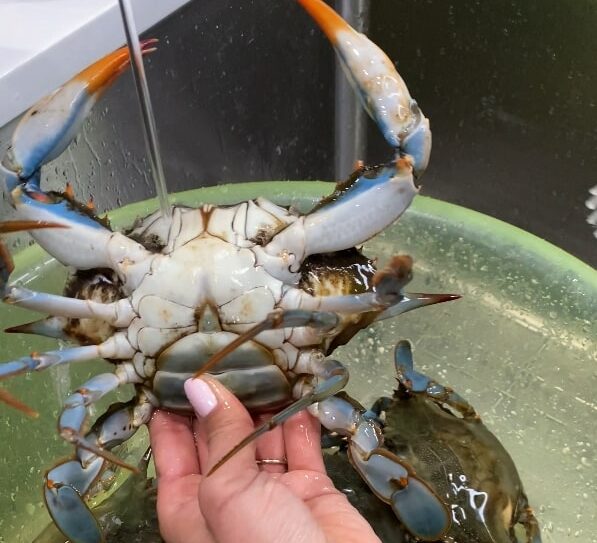
Step 3:
Remove the apron. Lift the apron from the body and twist it off. It helps to lay the crab on a flat surface and hold it down with one hand while twisting the apron off with the other.
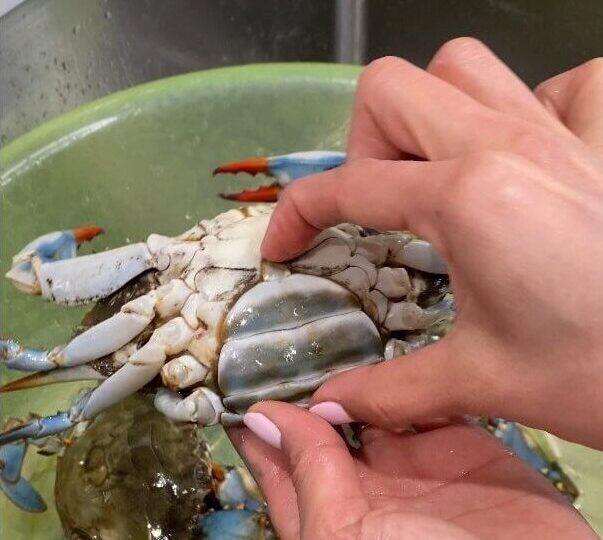
Step 4:
Place your non dominant thumb on the furthest leg to the back with a firm grip, and pull the shell off with your other hand. It is totally fine if the shell breaks- it will take practice getting it off in one smooth motion.
Do not throw away the shells that are removed. We will be coming back to those.
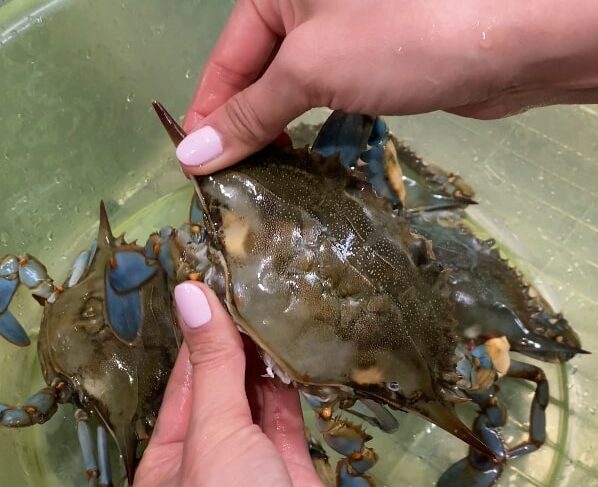
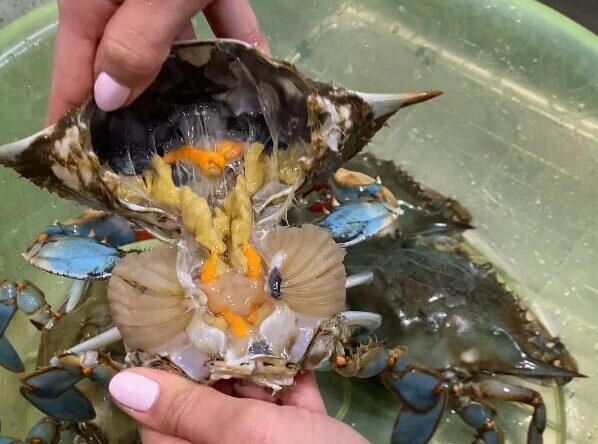
Step 5:
Remove the gills. The gills are edible- you can leave them on if you’d like but they are traditionally removed for this dish.
After the gills are removed, cut off any protruding pieces of shell and body parts that we will not be consuming, such as the eyes/mouth area and spikes.

Step 6:
Cut the body in half, then cut off the ends of the legs and the claw. Cut off the spikes, then make some cracks in the large leg so that the sauce can get inside, and so that it’s easier to eat later.
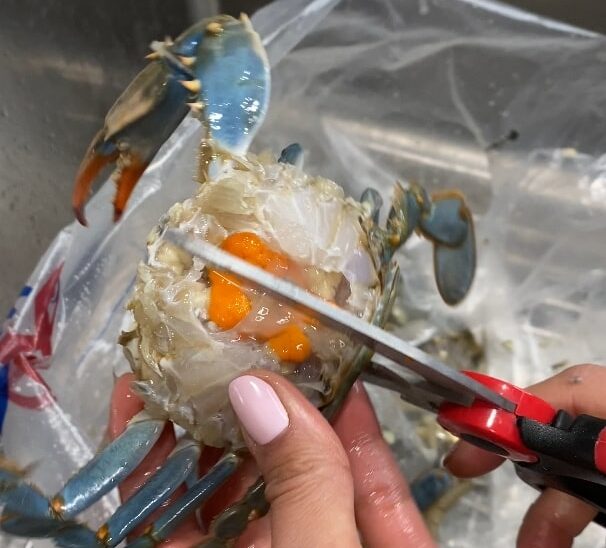
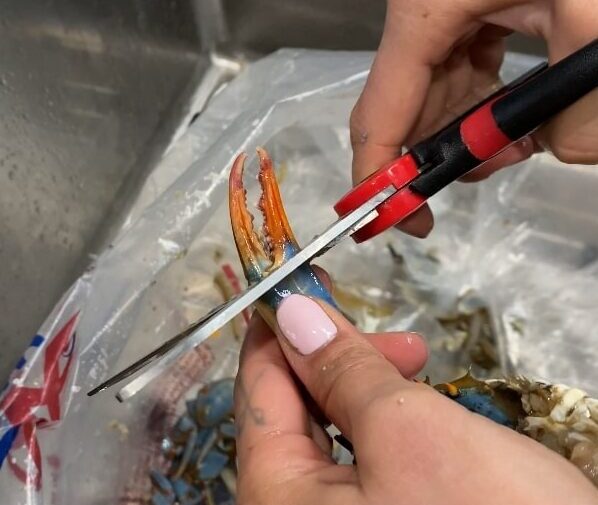
Step 7:
Pictured below is what you should end up with (2 pieces per crab, but I forgot to cut off spikes and make dents in this picture). Once you get to this point, give them another good wash (careful not to remove the fat and eggs) then place them in the refrigerator while we work on collecting more fat and eggs from the outer shells.

Step 8:
Gather the eggs and fat from the shell. Wash away the black stuff surrounding it. Sometimes you will find a lot of fat and eggs deep within the crevices, so don’t be afraid to dig in there for all that extra umami!
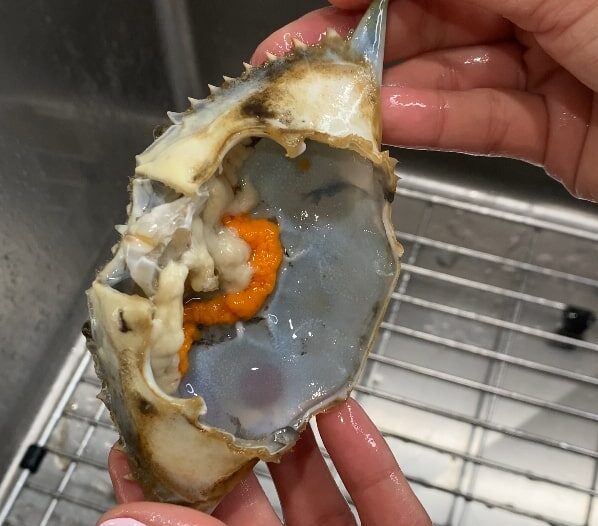
Step 9:
Add the fat & eggs to the cleaned crabs.
That’s it! That’s how you break down live blue crabs for yangnyeom gejang.
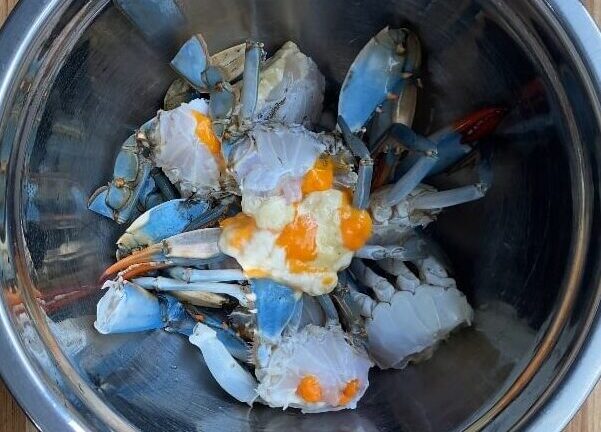
How to prep frozen crab
If using Korean frozen cut crab, it is best to thaw overnight in the fridge, but you can also just thaw it under cold running water. Just make sure the crab isn’t kept out at room temperature for too long.
Step 1:
Thaw the block of frozen crab in the fridge overnight or under cold running water. They do not have to fully thaw before you are able to pull them apart. Keep them as cold as you can during this process.

Step 2:
Gently pull the crabs apart and cut off the ends of the legs where there is no meat. Cut off the claws, then make cracks in the large leg so that the sauce can get inside, and so that it is easier to eat later. You can either use your scissors to cut some cracks, or use the handle and pound gently.

Step 3:
Give the cleaned crabs another quick rinse, scrubbing off any dirt that may still be left.
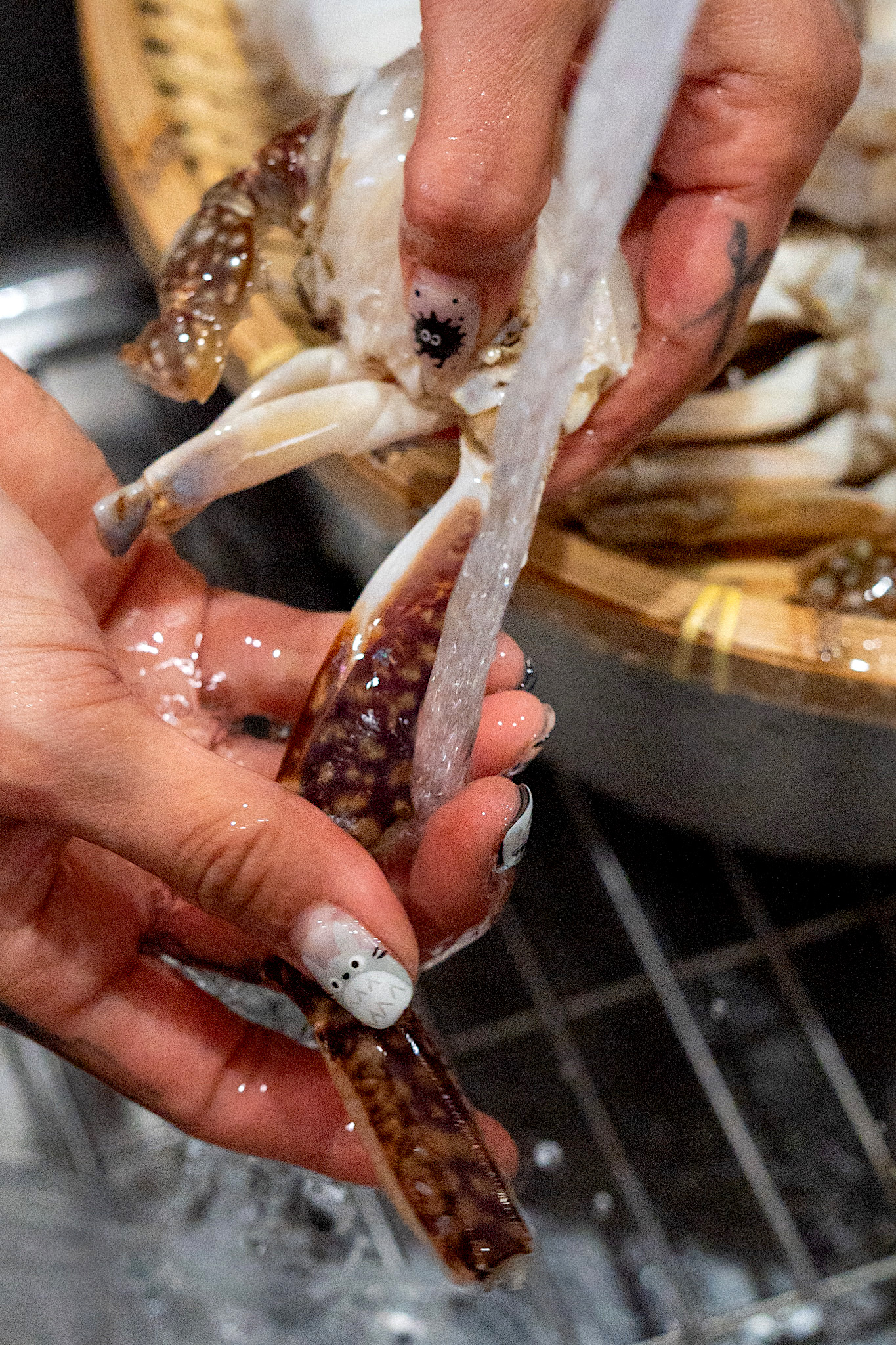
Step 4:
Drain in a colander and hold in the fridge while you make the seasoning sauce.
*if you were not able to find the brand I recommended earlier in this post (Wang Korea), I recommend soaking the cleaned crab in soju and lemon juice at this time. The other brands tend to be of lesser quality and have an unpleasant fishiness to them. The soju and lemon juice will help with that. Let it soak for 30 minutes in the fridge, then drain and pat dry with paper towels.
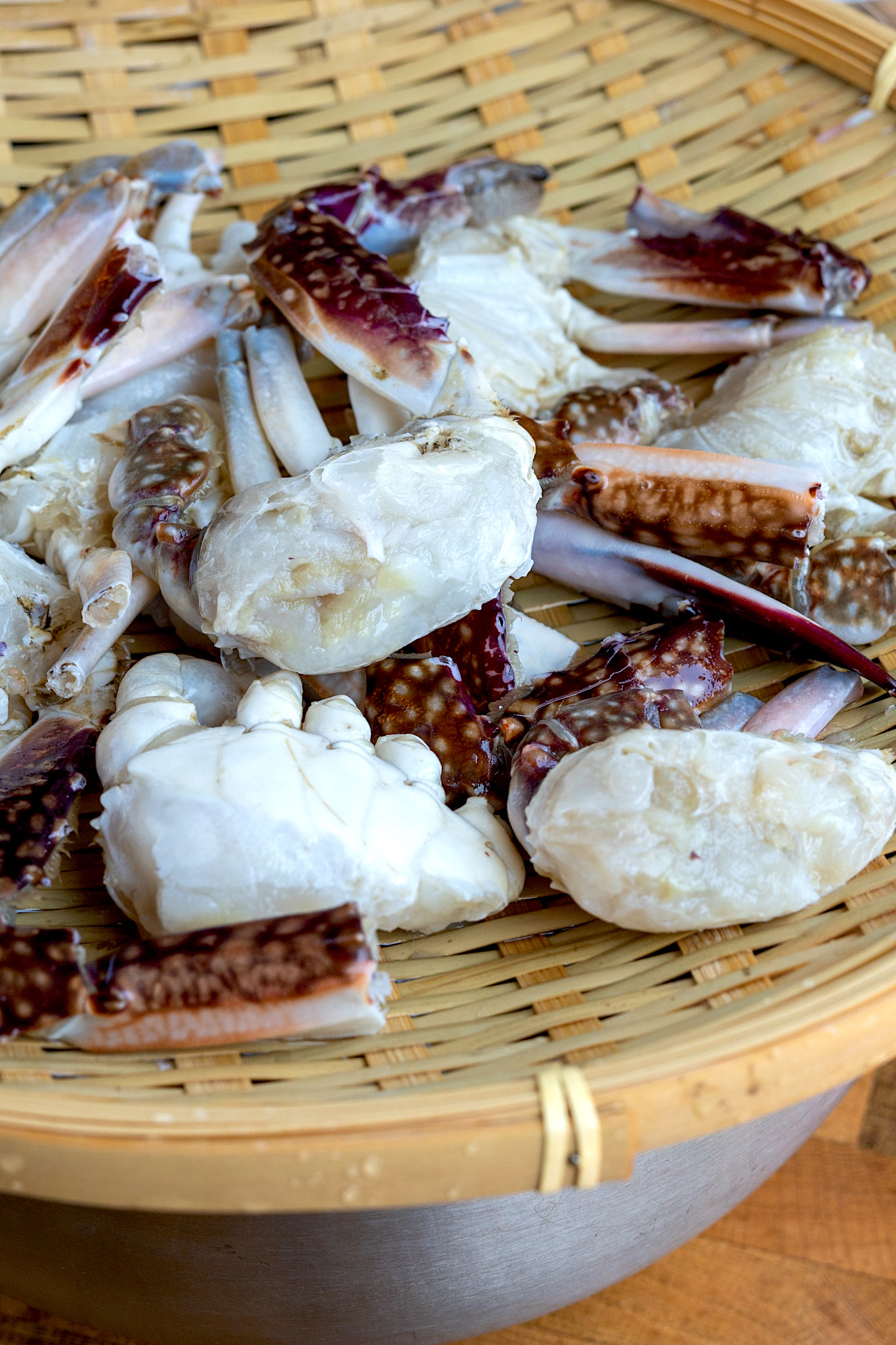
Spicy Sauce Ingredients
I do not like my yangnyeom gejang to be too sweet. If you prefer it on the sweeter side, add more sugar or plum syrup! And you probably won’t need the rice porridge.
Gochugaru (Korean red pepper flakes)– this is the most important ingredient, it is not optional and there are no substitutes.
Plum syrup- this is my preferred syrup sweetener for most Korean dishes because of its tartness, but it is not absolutely required for this dish. Use any sweetening syrup you want.
Sugar- just plain granulated white sugar
Fish sauce- I always use Three Crabs fish sauce
Soy sauce- my mom says that yangnyeom gejang shouldn’t be made with soy sauce, only fish sauce. But my aunt uses soy sauce and I actually prefer her sauce, so I use both and I think this is the best version.
Sesame oil- I LOVE sesame oil, but too much can overpower any dish. You only need a little, don’t overdo it! I always use the Kadoya brand.
Plum vinegar- this is another one of my preferred ingredients, but again it is not absolutely required. You can use white vinegar, just use a tad bit less because it is stronger.
Garlic, ginger, thai chili pepper- crushed using a mortar and pestle before adding the rest of the ingredients.
Rice porridge- you only need to make this if you don’t like your gejang too sweet (more on this below).
Msg & black pepper- a little msg for extra umami never hurts! And you’ll need black pepper as well.
Note: If you can find spicy Korean peppers, I highly recommend using that instead of thai chili peppers. My family is from Busan so we call it “ddaengcho” (땡초), but the standard name for it is “cheongyang gochu” (청양고추). For some reason, I’ve only been able to find them at a Korean supermarket once or twice. If you can get them, definitely use them!
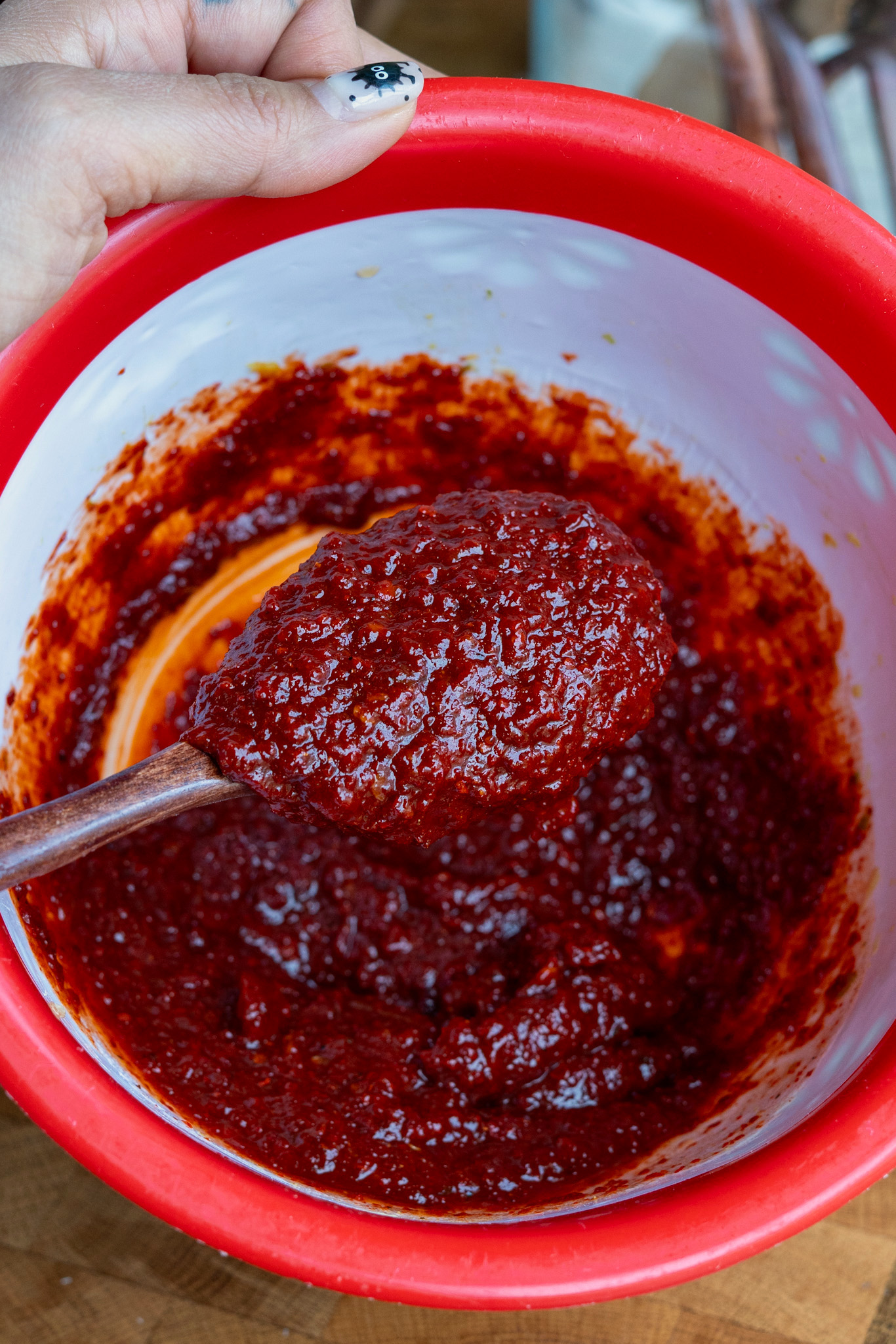
Is the rice porridge required?
If you prefer a sweeter sauce, you can probably get away with not making the rice porridge. Rice porridge is traditionally used to make the seasoning sauce for kimchi for a couple of reasons- it makes the sauce stick better, gives you more of that delicious kimchi brine, and it’s also healthy feed for the fermentation process.
The main reason I use it is because my recipe doesn’t have a lot of liquid sugars (syrup) since I don’t like it too sweet. So the viscous consistency of the rice porridge helps to make a sauce that sticks to the crab better, and also has a better mouthfeel/appearance.
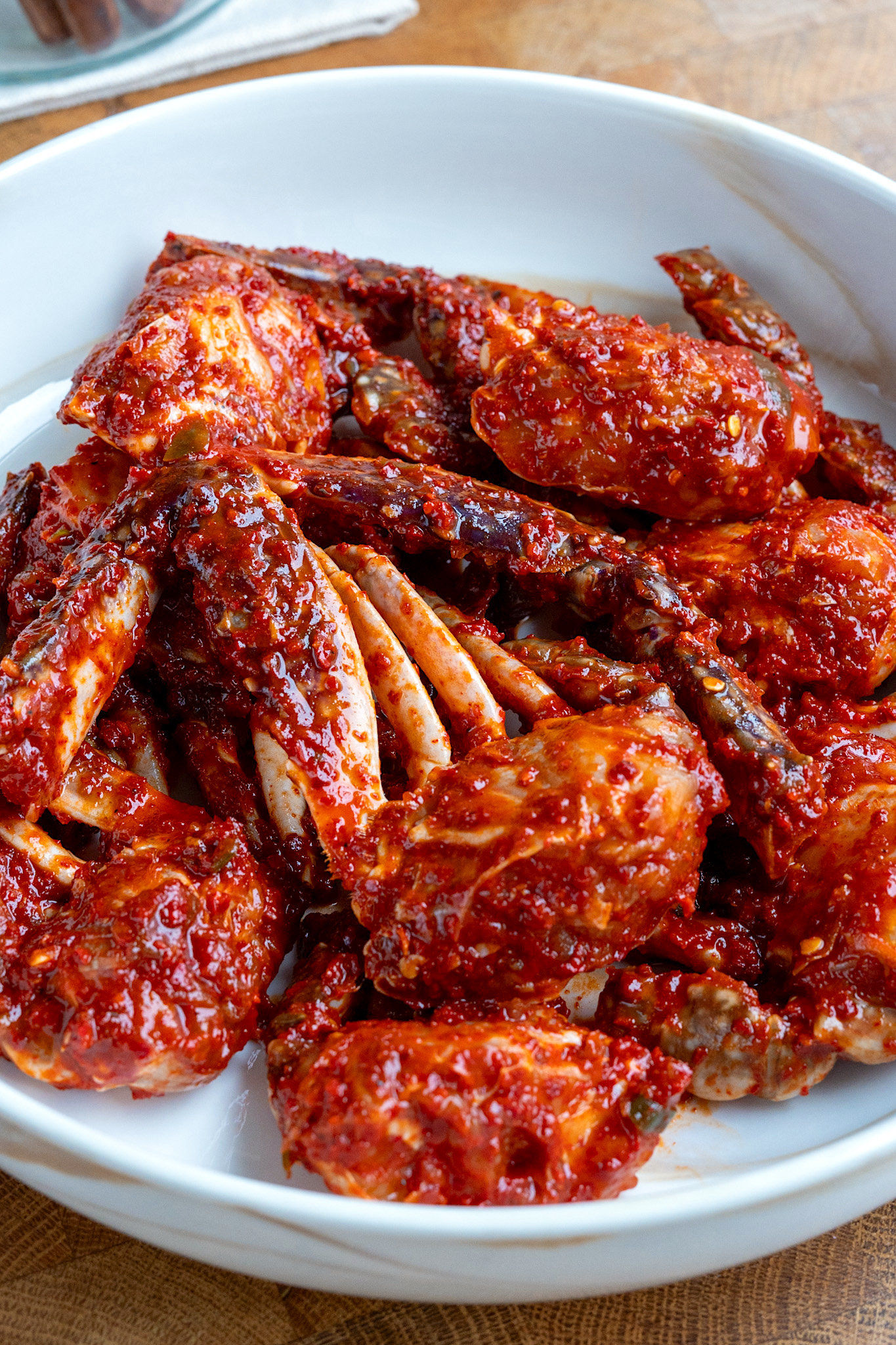
How long should it marinate and how long will it keep in the fridge?
You can eat them right away, but I prefer to wait at least 6 hours. One whole day of marinating in the fridge is even better, if you can wait.
I recommend eating them after one day, and finishing them by day 2 for optimal texture. They are good up to 5 days in the fridge but after day 2, it starts to get too mushy for my taste (but I will still eat it of course).
How to eat yangnyeom gejang
If you aren’t familiar with this dish, I bet you’re wondering how the heck you eat it. There is no graceful way to eat this dish- it will get messy!
To get the meat, you have to scrape it out with your teeth kind of like how you would eat edamame. That, and a lot of sucking. Same with the legs, although you won’t get as much meat out of those. There can be a decent amount in the claws, but you need to be careful eating around that area because the shells can get stuck between your teeth.
You can also just squeeze it out with your hands, but you’d leave some meat behind and need to scrape it out with your teeth anyway.
This dish is considered “bap do-duk” in Korea, which means “rice thief.” This term refers to any dish that is so flavorful and addicting, that you end up eating more rice than usual. This is a dish that should be eaten with a fresh bowl of steamed rice. You can eat gejang by itself if you want to, and sometimes it is even served as a banchan (side dish).
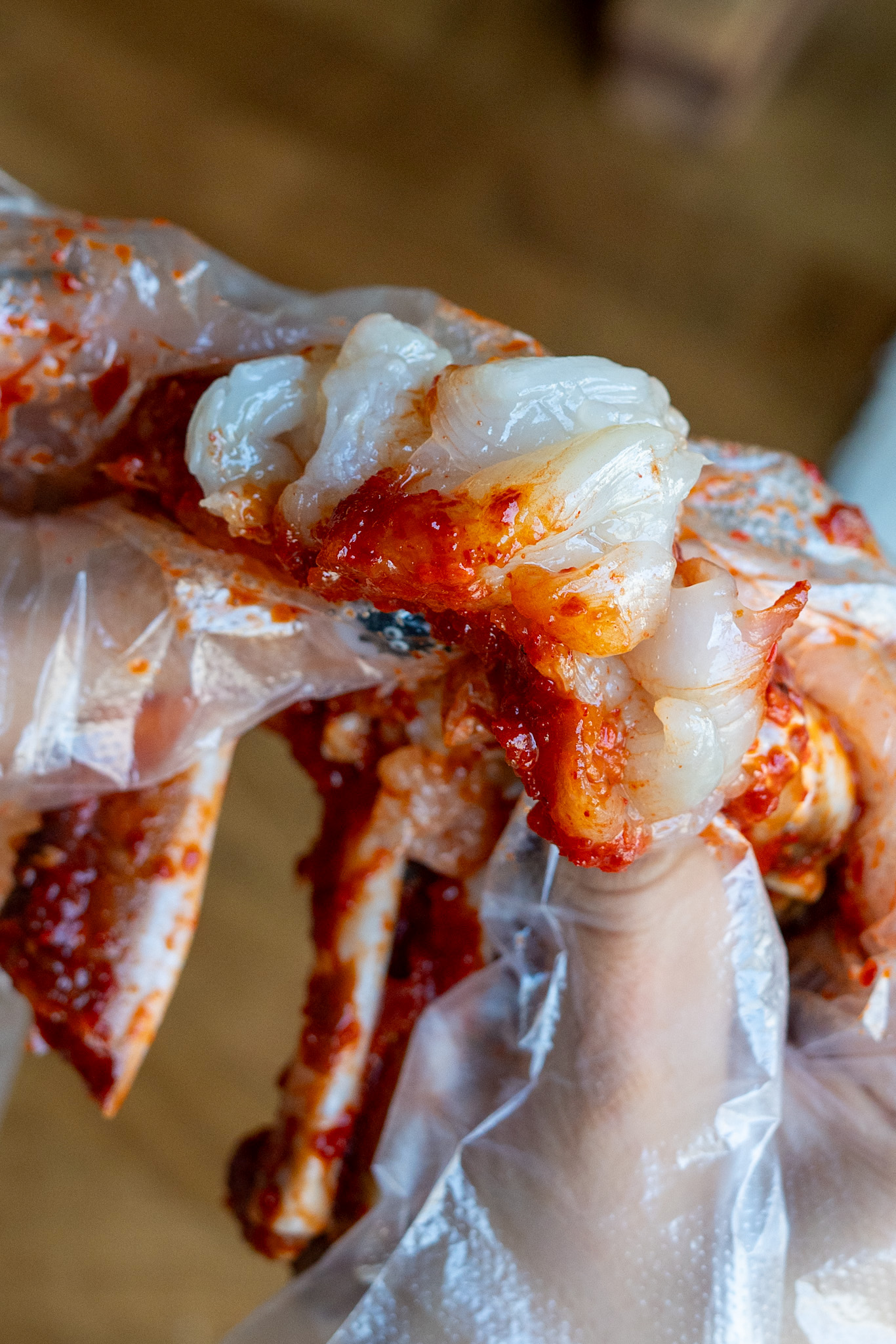
More spicy Korean dishes
Most spicy Korean dishes use a lot of the same ingredients, even though they can taste totally different! If you like yangnyeom gejang, you might like some of these other spicy dishes:
- Dakdoritang– this spicy chicken stew is one of my favorite Korean comfort foods! So good with rice, especially on a cold day.
- Tteokbokki– these spicy rice cakes are my absolute favorite Korean street food.
- 15-minute Dwaeji Bulgogi– perfect for your next kbbq night at home!
- Galchi Jorim- this is a lesser-known Korean dish made with belt fish and Korean radish. Don’t sleep on this one- it is extremely delicious and different!
- Ojingeo Bokkeum– this spicy stir fried squid is so flavorful and easy to make!
Recommended
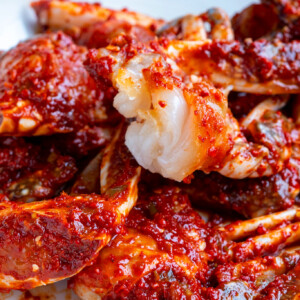
Yangnyeom Gejang- 양념게장 (Spicy Raw Crabs)
Ingredients
- 2 lbs live blue crab or frozen Korean blue crab
- 1 tsp sesame seeds
- 1 lemon wedge
- 1/4 cup soju
Seasoning sauce
- 5 tbsp gochugaru (korean pepper flakes)
- 1 tbsp soy sauce
- 3 tbsp fish sauce
- 2 tbsp plum syrup, (or any sweetening syrup)
- 1 tbsp sugar
- 2 garlic cloves
- 1 tsp fresh ginger
- 2 tbsp sesame oil
- 1/2 tsp plum vinegar, or white vinegar
- 1/4 tsp msg, optional
- 1/4 tsp black pepper
- 5 thai chili pepper, roughly chopped optional (very spicy)
- 1/3 cup rice porridge
Rice porridge
- 1/2 cup water
- 1 tsp glutinous rice flour
Instructions
- If using live blue crab, put the crabs in the freezer for 2 hours to put them to sleep.
If using frozen crab:
- If you're using frozen crab, it's best to thaw it the fridge, but you can also run the block of frozen crab under cold running water.
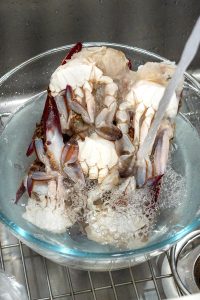
- Gently pull the crabs apart as its thawing. You may find some fishing lines as well, just throw those away. Using kitchen shears, cut off the ends of the legs where there is no meat. Cut off the pinchers, then using the handle of the shears, carefully pound along the big claw to make cracks (or cut the cracks) so that it's easier to get the meat out, and so that the meat gets marinated by the seasoning sauce better.
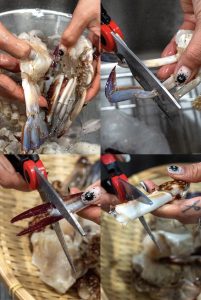
- Give the cleaned crab one final rinse under cold water, then drain in a colander and keep in the fridge until ready to marinate in the sauce.
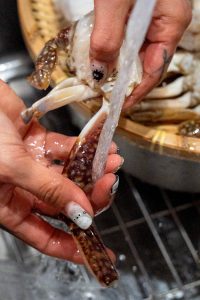
- *Skip this step if you're using fresh live crab, or if you were able to find the brand of frozen crab I prefer (pictured in the blog post). Any other brand of frozen crab will likely be unpleasantly fishy and needs this step. After cleaning up the frozen crab, squeeze some lemon juice all over, then add soju and toss to coat evenly. These are going to help get rid of any excessive fishiness since these are not fresh crab. Let it sit in the fridge for 20-30 minutes.
- After 20-30 minutes (you should be making the rice porridge and seasoning sauce during that time), drain the lemon juice and soju, then use paper towels to pat the crab dry. Keep in the refrigerator.
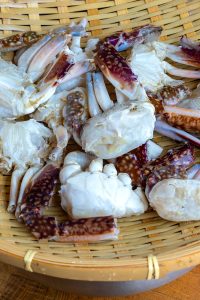
Make the rice porridge & seasoning sauce
- Add 1/2 cup cold water and 1 tsp of glutinous rice flour to a small sauce pan. Mix until dissolved, then cook over low heat stirring frequently until thickened. The consistency should be a little thicker than pancake batter. Let it cool completely before adding it to the seasoning sauce.
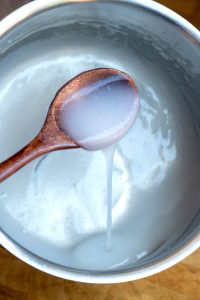
- Roughly chop the thai chilis, then crush them using a mortar and pestle along with the garlic and ginger.
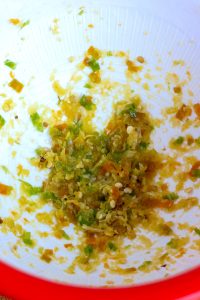
- Mix all the seasoning sauce ingredients together. I don't like it as sweet as restaurants usually make it so if you prefer it sweeter, add more sugar and/or plum syrup.
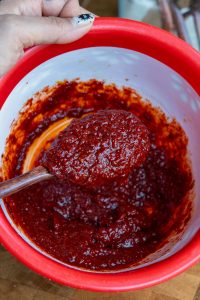
How to break down live blue crab (skip this if you're using frozen crab)
- After 2 hours, the crabs should be asleep and easy to handle. Scrub them under cold water with a stiff brush.
- To break down the crab, lift the apron and remove it by twisting it off. It helps to lay the crab on a flat surface and holding it down.
- Place your non-dominant thumb on the furthest leg to the back with a firm grip, then pull off the shell with your other hand.
- Remove the gills and mouth area with kitchen shears, and then cut the crab in half. Cut off any protruding shell pieces so its easier to eat around.
- Cut off the ends of the legs and the claw, then make some cracks in the big leg so the marinade can get inside and so that its easier to eat later.
- Give it another good rinse, making sure you don't throw away any of the eggs and fat.
- Put the cleaned crabs back in the refrigerator while we finish the next steps (you don't want to keep them out in room temperature for too long).
- Next, clean out the shells under cold water. Remove all the black stuff so that you can scrape out the eggs and fat, then add them to the cleaned crabs. You can throw away the shell.
Marinate the crab
- Mix the seasoning sauce & and crabs together until fully coated. Wear latex or plastic gloves when handling- it may stain your hands and/or sting from the spiciness.

- Sprinkle some sesame seeds (optional) and store in the refrigerator for at least 6 hours before eating, but 1 day would be best!

- Enjoy with a fresh bowl of rice.
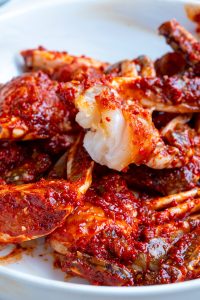
Nutrition information is automatically calculated, so should only be used as an approximation.
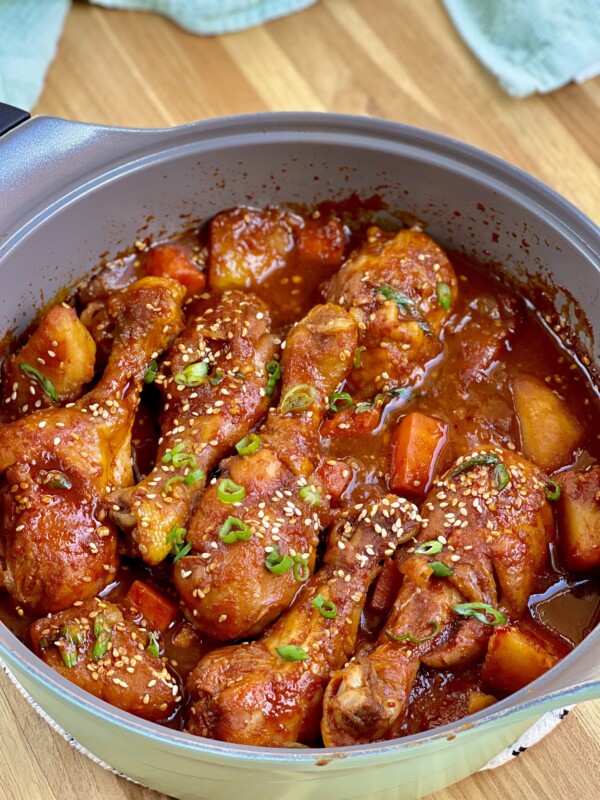
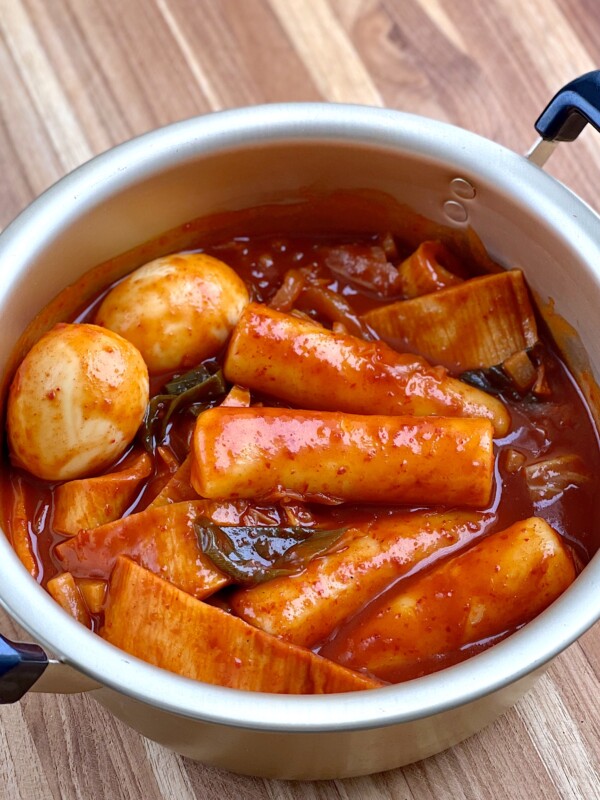
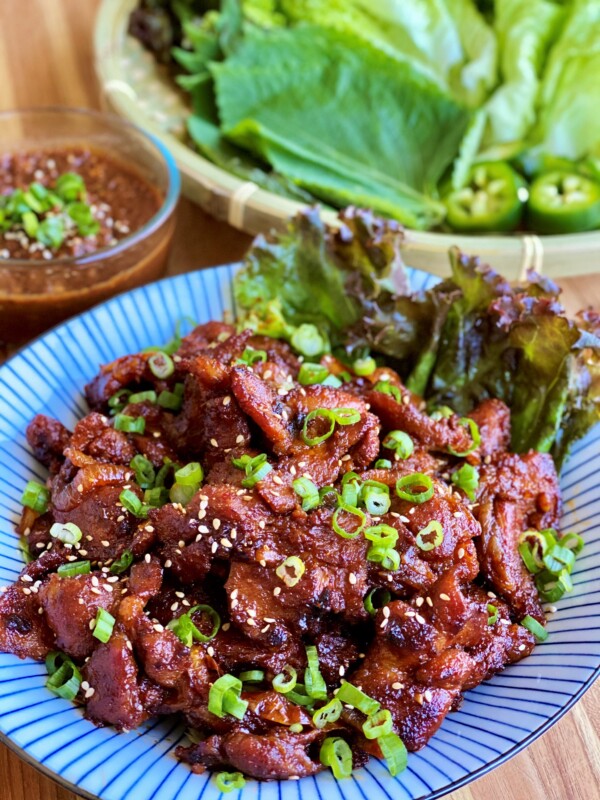
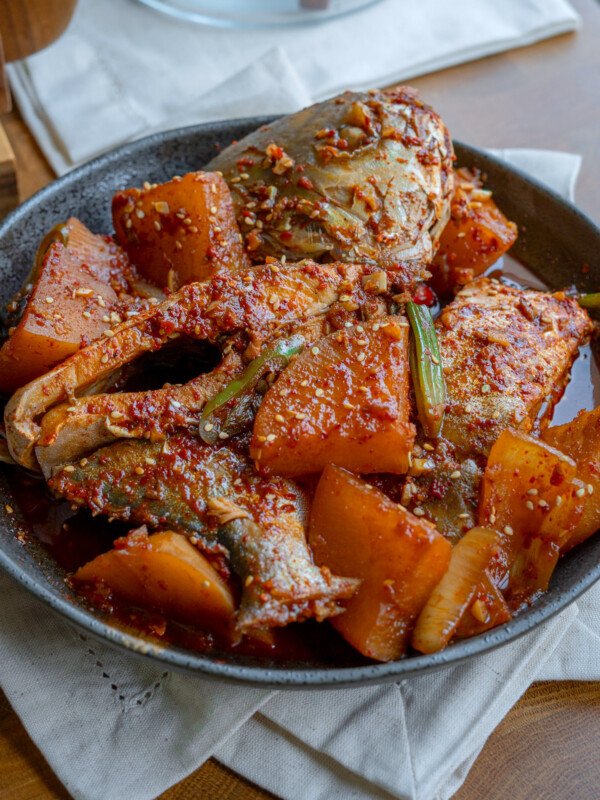
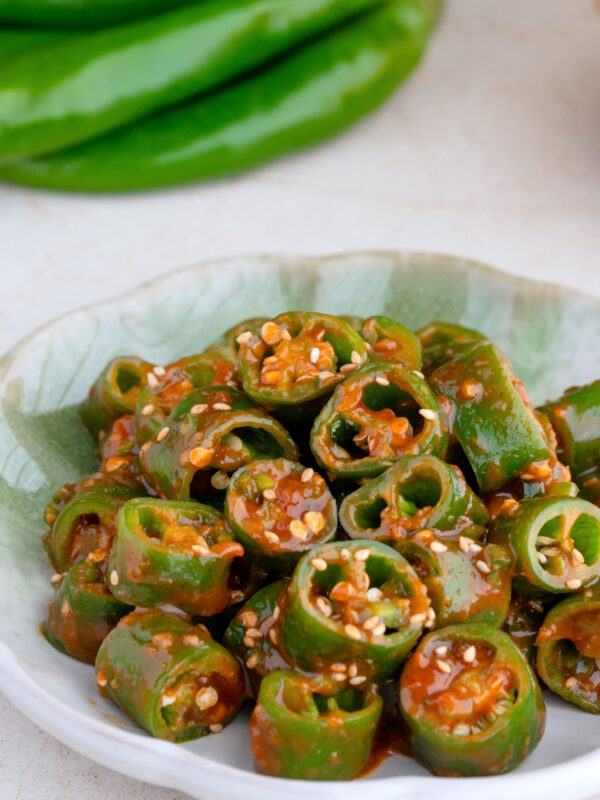
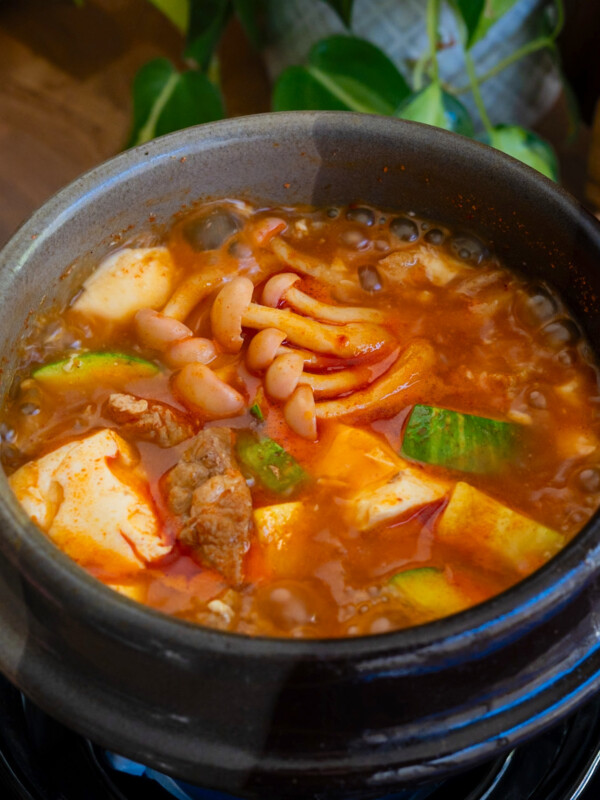
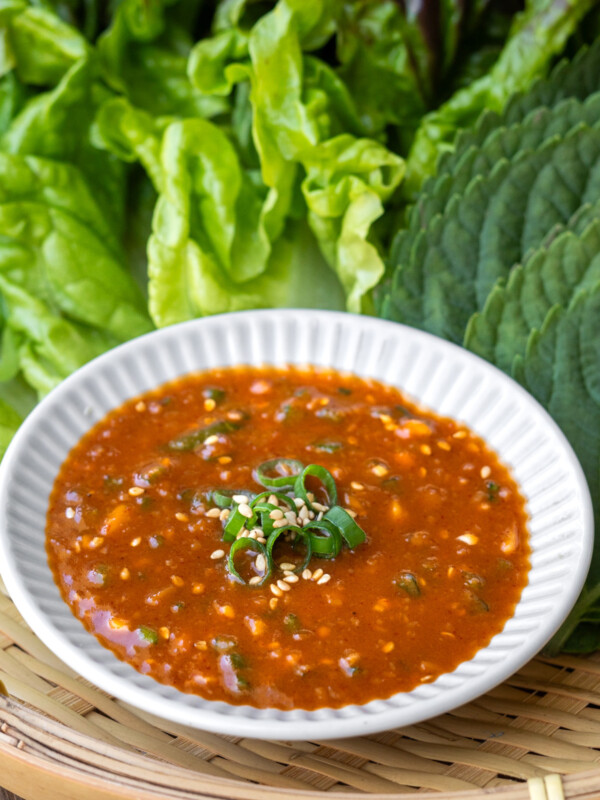
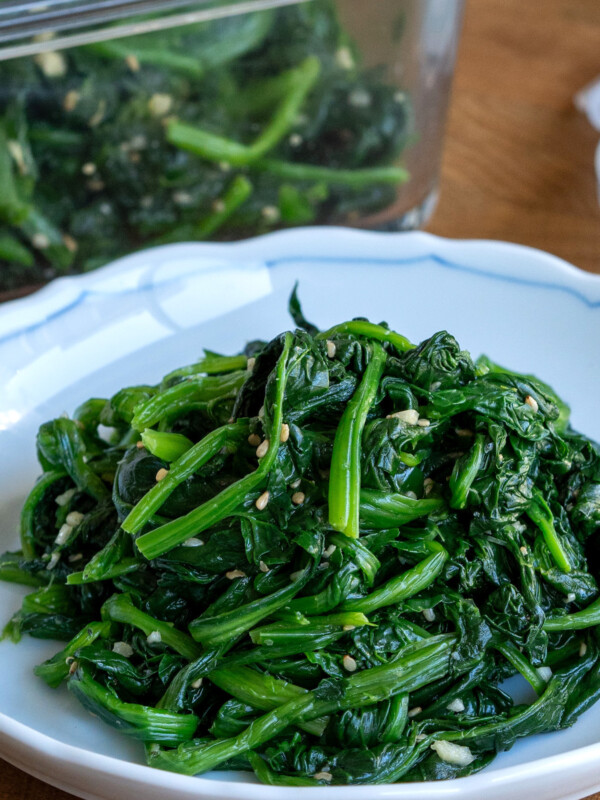







i’m confused. when you mentioned to not use dead crabs, aren’t frozen crabs dead?
Hi Stephanie, sorry for the confusion! To be clear, you should never use fresh crab that are already dead. The cut frozen crab that I use are flash frozen as soon as they are broken down, and they were alive before processing. The distinction here is that the crab need to be alive when breaking them down, which prevents harmful enzymes from decomposing the body. Hope this helps!
Love this recipe! I was wondering if I can substitute the lemon juice for lime juice? I have many limes on hand from my tree.
I made these so many times! Sometimes I change it up to shrimps but the sauce is always so good! I find this recipe to have the perfect balance of sweet and salty! I have learned so much from you Stella, not only from this recipe but others as well! Thank you for always sharing the best recipes!
This recipe is SO good! If you are craving an authentic Korean flavor raw crab, this is the recipe to try!
This recipe taste like my grandma’s spicy crab recipe! Brings back so many wonderful childhood memories of her!
This is my favorite recipe! It’s sooo delicate, juicy, and addicting. I make this when I can find fresh raw crabs! Thanks for sharing your love for food and recipes!
Made this dish at home for the 1st time and my family and I absolutely loved it. Never had marinated raw crab before but after creating it, this dish was added to my food to create during lent.
Thank you for sharing this recipe and many more.
So freaking good! I want to eat this marinate with everything. Learning to clean a crab was definitely a process but we’ll worth the effort. Doubled the chili peppers to make it Thai spicy.